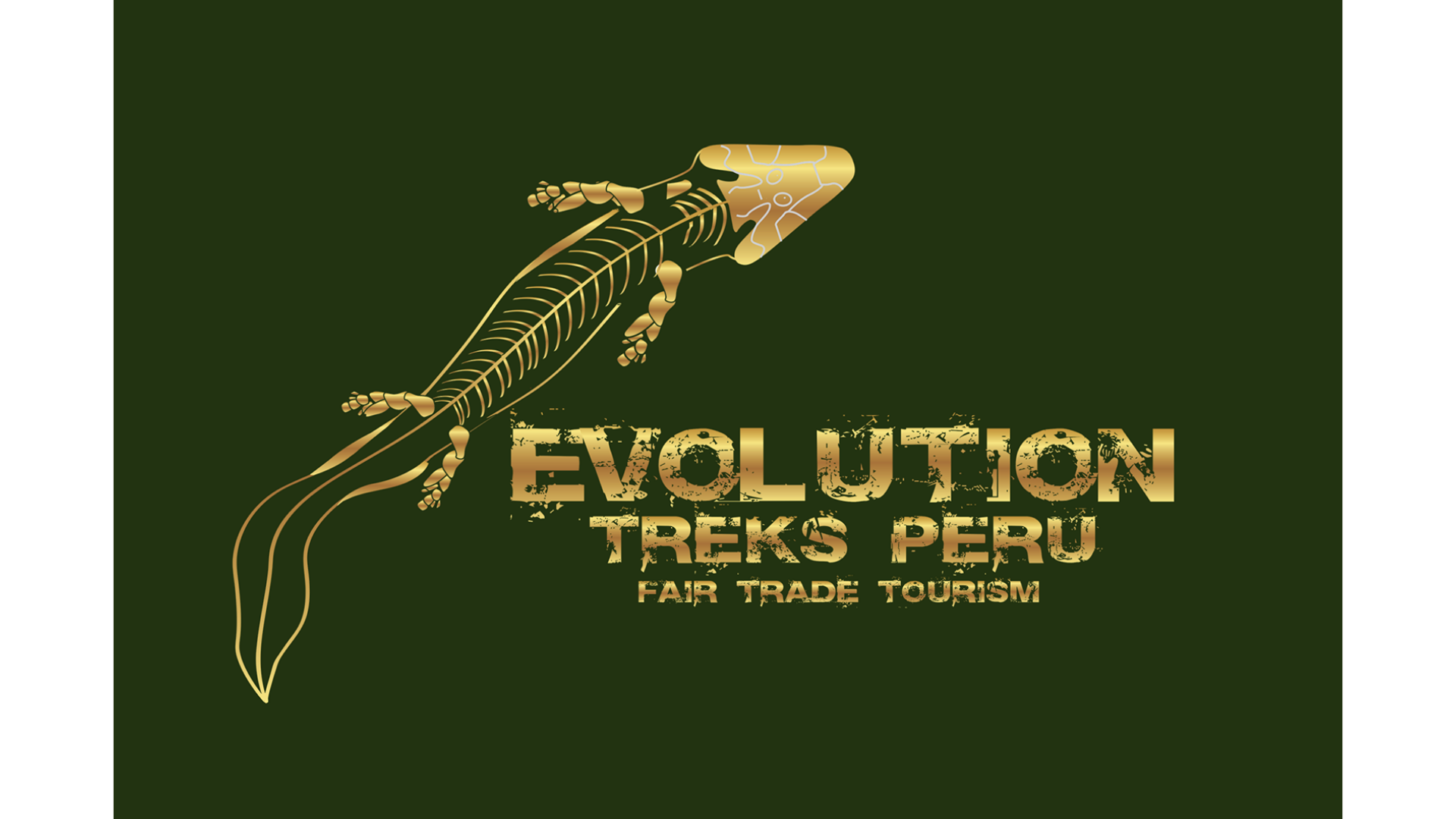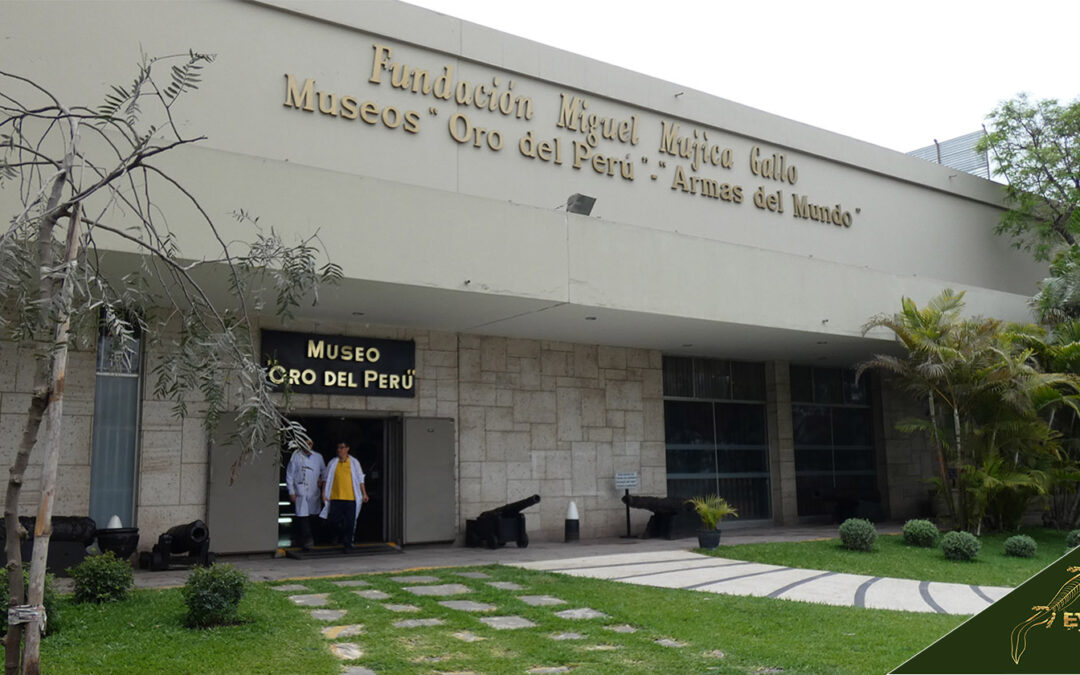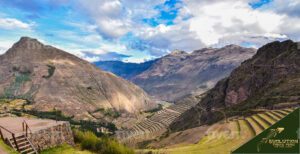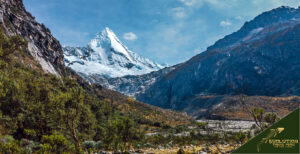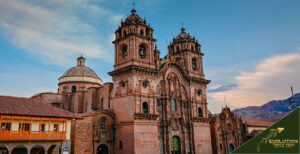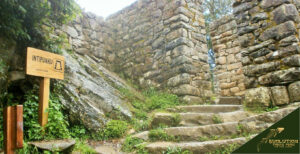The Gold Museum of Peru and Weapons of the World is an archaeological and military museum located in the Santiago de Surco district, Lima, Peru. It was created from the private Collection of Peruvian businessman Miguel Mujica Gallo in the 1960s. The two-story building preserves a valuable collection that includes gold, silver, and platinum objects; textiles; ceramics; mummies, etc., all donated by Mr. Mujica Gallo to the Peruvian State for conservation purposes through his Foundation administered by Camila Pérez Palacio Mujica.
This collection provides insight into what Spaniards found when they arrived in Peru – cultural advances such as metallurgy techniques with complex magical-religious symbolism attached to them as well as customs & beliefs of pre-Inca cultures like Vicus, Mochica Lambayeque & Chimú, etc., followed by Inca Empire’s riches with solid gold disk representing sun god Inti & Mama Quilla goddess among other artifacts adorning Coricancha temple walls covered with plates made up precious metals along with ornaments from Frias Chancay Ica Nazca civilizations crafted skillfully using openwork embossed nose rings filigree games figures birds men monkeys.
In addition to its Peruvian content, there are more than 20 thousand weapons on display collected by Mr. Mujica Gallo during his travels abroad dating back to the 13th century B.C., along with war uniforms & other objects that marked different eras through time & history for over 3000 years. Visits cost between US$40 – US$55 per person, depending on the tour chosen. Group visits must have 6 – 10 people maximum; entrance fee for adults is 33 soles/7 euros while discounts apply for children under 14 yrs old/senior citizens/university students at 16 soles/4 euros.
What is the history of the Gold and Weapons of the World Museum?
The history of the Museum of Gold of Peru and Weapons of the World begins with the history of the private collection of Miguel Mujica Gallo. He was the founder of the Gold Museum of Peru and the creator of the Foundation of the same name. He began his life as a collector at a very early age, and his love for hunting introduced him to the acquisition of antique weapons.
When he saw a pre-Columbian Tumi (ceremonial knife), he was fascinated by it, so it was with this piece, and others recently acquired that he began his interest and admiration for the pre-Columbian archaeological world. His collections of weapons and pre-Columbian Peruvian pieces constitute since 1966 (in his headquarters in Monterrico) the museums “Gold of Peru” and “Weapons of the World.”
The Miguel Mujica Gallo Foundation administers the Museum, created specifically to conserve the collection gathered over several years. Camila Pérez Palacio Mujica currently directs the Foundation.
What does Museo de Oro del Perú y Armas del Mundo mean?
The Gold Museum of Peru and Weapons of the World is an archaeological and military museum located in the district of Santiago de Surco (also uniquely called Surco), in Lima (Peru). As its name indicates, we will be visiting two museums (one dedicated to exhibiting millenary pieces of gold metals and traditional Peruvian art and another that allows us to admire one of the best collections of weapons of war of all kinds worldwide).
What artifacts are found in the Museum of Peruvian Gold and Weapons of the World?
- The Museum of Peruvian Gold and Weapons of the World houses a collection of gold artifacts, weapons from all over the world, antique tapestries, and textiles.
- The Museum showcases pieces from Pre Inca civilizations such as Moche, Sipan, Mochica Lambayeque, and Chimu, including tumis necklaces, bracelets, hats, earrings, pectorals, and other accessories crafted by goldsmiths throughout several centuries.
- On the top floor is an impressive collection of weapons with uniforms considered one of the most complete in the world; it also displays mummies, funerary bundles original head offerings known as “trophy heads”.
- Twenty thousand weapons are exposed to visitors along with war uniforms, armor horse saddles, spurs objects that marked epochs through time belonged to some main characters in history like Simón Bolívar José de la Riva Agüero Napoleon Bonaparte Francisco Pizarro etc.
- The Tizona, sword of Francisco Pizarro. Conqueror of Peru.
- In the showcases of the Weapons of the World Museum, you can find uniforms of illustrious characters such as Simón Bolívar and José de la Riva Agüero, as well as pieces of exceptional beauty and interest such as Napoleon Bonaparte’s strategy game and Francisco Pizarro’s sword.
- Flintlock pistols manufactured in Versailles belonged to Napoleon I (1804-1814). The wooden base is carved with imperial eagles and an N on the butt.
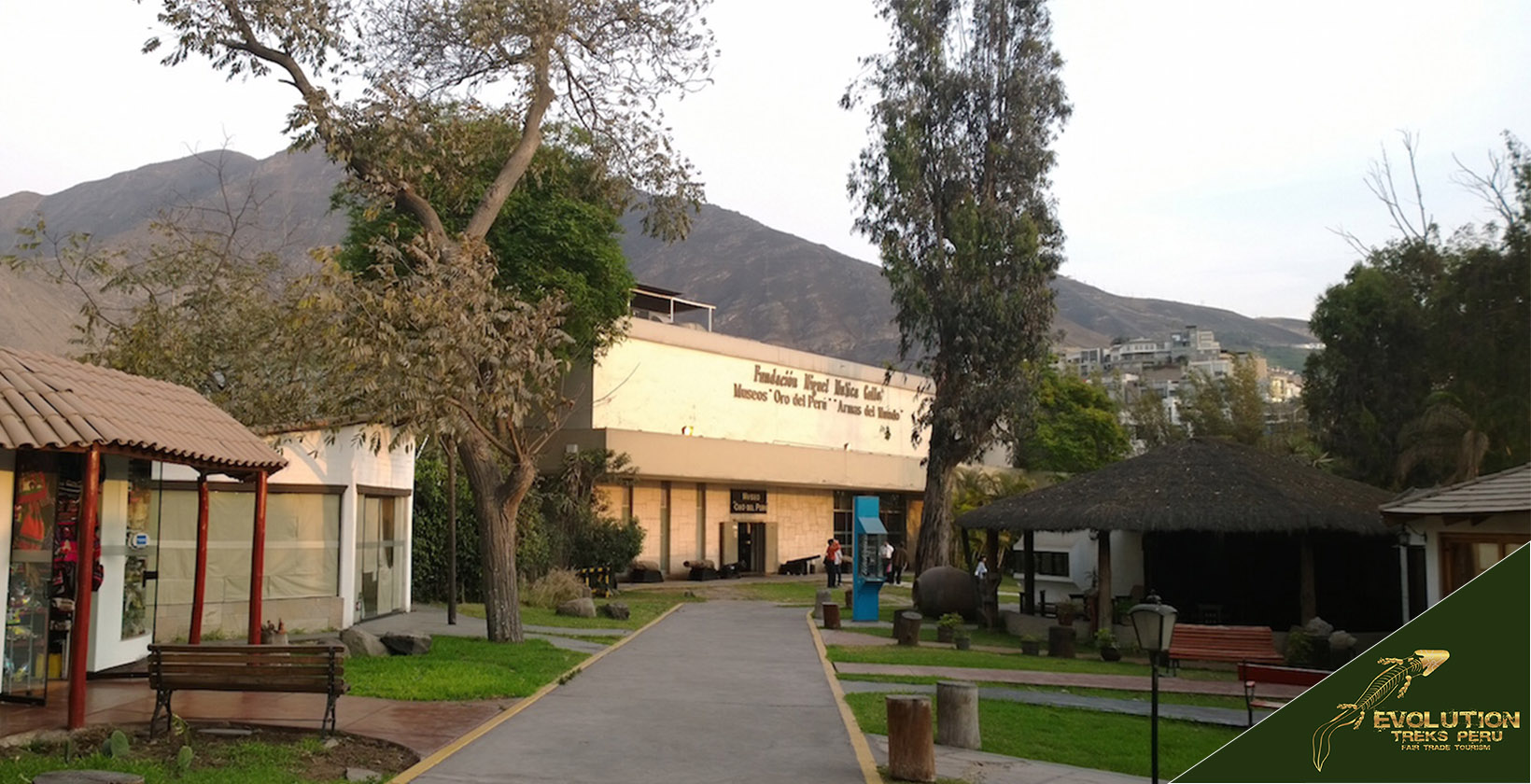
When did the Gold Museum of Peru and Weapons of the World get its name?
The Museum of Gold of Peru and Weapons of the World obtained its name in 1966.
Before creating the Museum of Gold and Weapons of the World, Miguel Mujica Gallo traveled worldwide, which allowed him to acquire different objects and weapons from different cultures and countries.
Once he returned to Peru, he was offered more than 300 pieces obtained through looting several archaeological sites. Although he was only interested in one “Tumi,” a highly ornamented ceremonial knife made entirely of solid gold, his wife, Aída Diez-Canseco Bernales, encouraged him to buy the entire collection.
Since then, the pre-Inca and Inca collection grew large enough to be exhibited in several countries in the Americas and Europe, with the sponsorship of the Peruvian government. Subsequently, Miguel Mujica Gallo founded the renowned Gold Museum of Peru in 1966 and later donated the entire collection to the Peruvian State.
What country used the Gold Museum of Peru and Weapons of the World, and for what purpose?
The Gold Museum of Peru and Weapons of the World were created in 1968 and administered by the Manuel Mujica Gallo Foundation. The Gold Museum of Peru showcases and exhibits the work of goldsmiths, made throughout several centuries of Peruvian history, mainly in pre-Inca gold. On the other hand, visiting the Weapons of the World Museum takes you on a retrospective journey through history as you learn about the world’s different cultures through their weapons, armor, and war uniforms.
What is the most important theory about the origin of the Gold Museum of Peru and Weapons of the World?
The best-known theory about the origin of the Museum of Peruvian Gold and Weapons of the World states that, before creating the Museum, Miguel Mujica Gallo traveled around the world. His travels allowed him to acquire various objects and weapons from different cultures and countries.
Once back in Peru, he was offered more than 300 archaeological pieces obtained from the looting of archaeological sites. Although he was only interested in a solid gold “Tumi” (ceremonial knife), his wife encouraged him to buy the entire collection.
Since then, the pre-Inca and Inca collections grew large enough to be exhibited in several countries in the Americas and Europe. Subsequently, Miguel Mujica Gallo founded the Gold Museum of Peru in 1968 and later donated the entire collection to the Peruvian State.
Is the Museum of Peruvian Gold and Weapons of the World important for the History of Peru?
The Museum of Gold of Peru and Weapons of the World is essential for the History of Peru by preserving and exhibiting valuable gold and silver objects for the national and international public, as well as Inca and pre-Inca textiles recognized as part of the traditional and millenary history of Peru.
The collection of ancient and modern weapons of the Museum of Weapons of the World is considered one of the best on the continent. The weapons’ quality, provenance, preservation, and quantity make the Museum a place of interest for all those interested in military history.
Where are the Gold Museum of Peru and Weapons of the World located?
The Museum of Gold of Peru and Weapons of the World is located in the city of Lima. In the district of Santiago de Surco, jirón Alonso de Molina 1100 is part of the Monterrico urbanization.
What is the Gold Museum of Peru coordinates?
The coordinates of the Gold Museum of Peru and Weapons of the World are as follows:
Coordinates
12°6′33″ S, 76°57′50″ W
In decimal
-12.109167°, -76.963889°
UTM
8660606 286261 18L

How did the Gold Museum of Peru and Weapons of the World become well known?
The Museum of Peruvian Gold and Weapons of the World became well known and recognized worldwide due to the variety, delicacy, and exquisiteness of the pieces worked with Peruvian gold and silver that is part of its collection on display. It presents to the public the magnificent work done by goldsmiths who made their works hundreds of years ago.
How is the Map of the Gold Museum of Peru and Weapons of the World?
The following is the map of the Gold Museum of Peru and Weapons of the World:
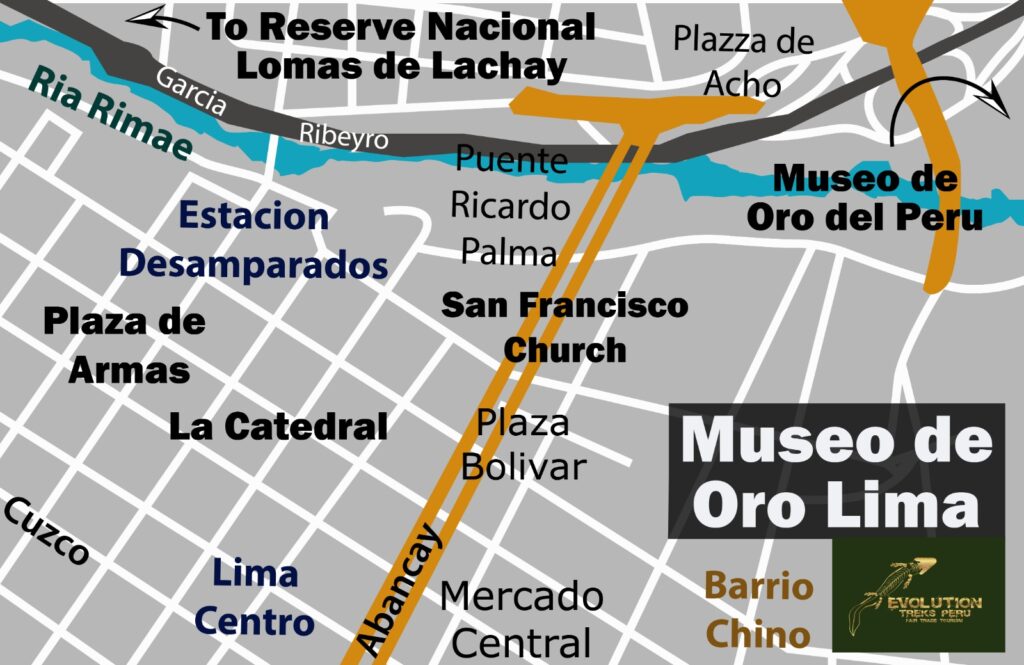
What museums are near the Museum of Gold and Weapons of Peru and the World?
The Museums near the Gold Museum of Peru and Weapons of the World are the following:
- The Automobile Museum Association is also known as the Jorge Nicolini Automobile Museum. This Museum is a must-see for any automobile enthusiast and houses a spectacular collection of vehicles manufactured between the beginning of the 20th century and the 1970s. Address: Avenida Vinas de la Molina, La Molina. Lima. Telephone: (01) 3680373
- The Raimondi Museum. This superb Museum was named after the Italian researcher Antonio Raimondi, who dedicated much of his life to researching Peruvian territory. This historical-cultural space is located in the district of La Molina and is under the administration of the Antonio Raimondi Educational Association. Address: Avenida La Fontana, 755, La Molina. Lima. Phone: (01) 614-9700 ext. 132
- The Klaus Raven Büller Museum of Entomology, also known as the Museum of Entomology of the National Agrarian University. This cultural space was created to exhibit a group of different insects that are registered in the country. Address: Avenida La Universidad, s/n, La Molina. Lima. Phone: (01) 6147800 Annex 330
All of the above museums are located in La Molina district, Lima.
When is the best time to visit the Gold Museum of Peru and Weapons of the World?
The best time to visit the Museum of Gold of Peru and Weapons of the World is in the spring and summer months when, in the city of Lima, the weather is pleasant.
The climate in Lima is most pleasant between December and March (temperatures around 24 ° – 30 ° C). From June to September, a low fog descends over the valley where the city is located, although temperatures are between 15 ° -20 ° C in June and 15-19 ° C in September.
Where to stay to visit the Gold Museum of Peru and Weapons of the World?
Considering their proximity, we recommend the following hotels during your visit to the Gold Museum of Peru and Weapons of the World and Lima.
Los Incas Lima Hotel
Located in an exclusive area very close to the business and commercial centers of Surco, as well as the Gold Museum and Weapons of the World. It is the closest hotel to the airport by the fast lane. Enjoy a beautiful panoramic view and many amenities.
Los Incas Lima Hotel
El Polo Apart Hotel & Suites
Polo Apart Hotel & Suites offers accommodation and restaurant services. The property is 500 meters from Surco Business Center. It is 1.5 kilometers from Jockey Plaza Shopping Center and 2 kilometers from the Gold Museum of Peru. Jorge Chavez International Airport is 27 kilometers away
Posada Bella Hotel
With a warm and cozy rustic style, it is the place where you will want to come to rest after a hectic day of work or sightseeing in the city.
You have at your disposal 8 spacious, comfortable and fully equipped apartments and suites that harmonize with the surrounding nature.
Address: Avenida Don Diego de Día 181, corner with Jirón Alfred Rosenblatt 205, Monterrico, Surco.
Posada Bella – Monterrico – Lodging in Monterrico, Executive Suites, Temporary Lodging, Lodging in Monterrico, Monterrico Accommodation
Lima Marriot Hotel
Recognized with the Readers’ Choice 2020 award from Condé Nast Traveler magazine as one of the 25 best hotels in South America. Set against the cliffs of the Miraflores district, the hotel offers a privileged location near local attractions such as the beaches of the Costa Verde, the Larcomar shopping center, Kennedy Park and the Barranco district, famous for its museums and art galleries.
Address: Malecón de la Reserva 615, Miraflores, Lima, Lima 18 Peru.
Luxury Hotels in Lima, Peru | JW Marriott Hotel Lima
What are the tours to visit the Gold Museum of Peru and Weapons of the World?
The Gold Museum of Peru and Weapons of the World offer the following in-depth tours.
- The Gold museum tour. The Gold Museum Tour takes visitors around the Museum’s impressive collection of gold artifacts, including a wide range of pre-colonial jewelry pieces, religious antiques, and other precious items. Guided by knowledgeable tour guides, visitors can learn about the history behind these unique items and hear stories about their creation and significance to Peruvian culture. During this tour, there are plenty of opportunities for photos and souvenir shopping in the Museum’s gift shop. Also, this tour is suitable for elders, families, and children.
- The Weapons of the World Tour is another popular option. This tour provides an opportunity to learn more about weaponry throughout history and its role in various cultures. Participants will get to explore seven galleries filled with fascinating weapons from all over the world—from ancient swords to modern firearms—and discover their importance to warfare through time. With knowledgeable guides leading them every step of the way, visitors can gain an understanding of how different types of weapons were used for defense or offense in different eras. The tour also includes a look at some unique replica weapons visitors might not find anywhere else.
How to get from Lima to the Gold Museum of Peru and Weapons of the World?
The best way to get from Lima to the Gold Museum of Peru and Weapons of the World is by using public transportation, cab service, or private car. If you are staying near the Museum, you can walk.
If you are visiting Lima for the first time, the best option is to take a cab to the Museum.
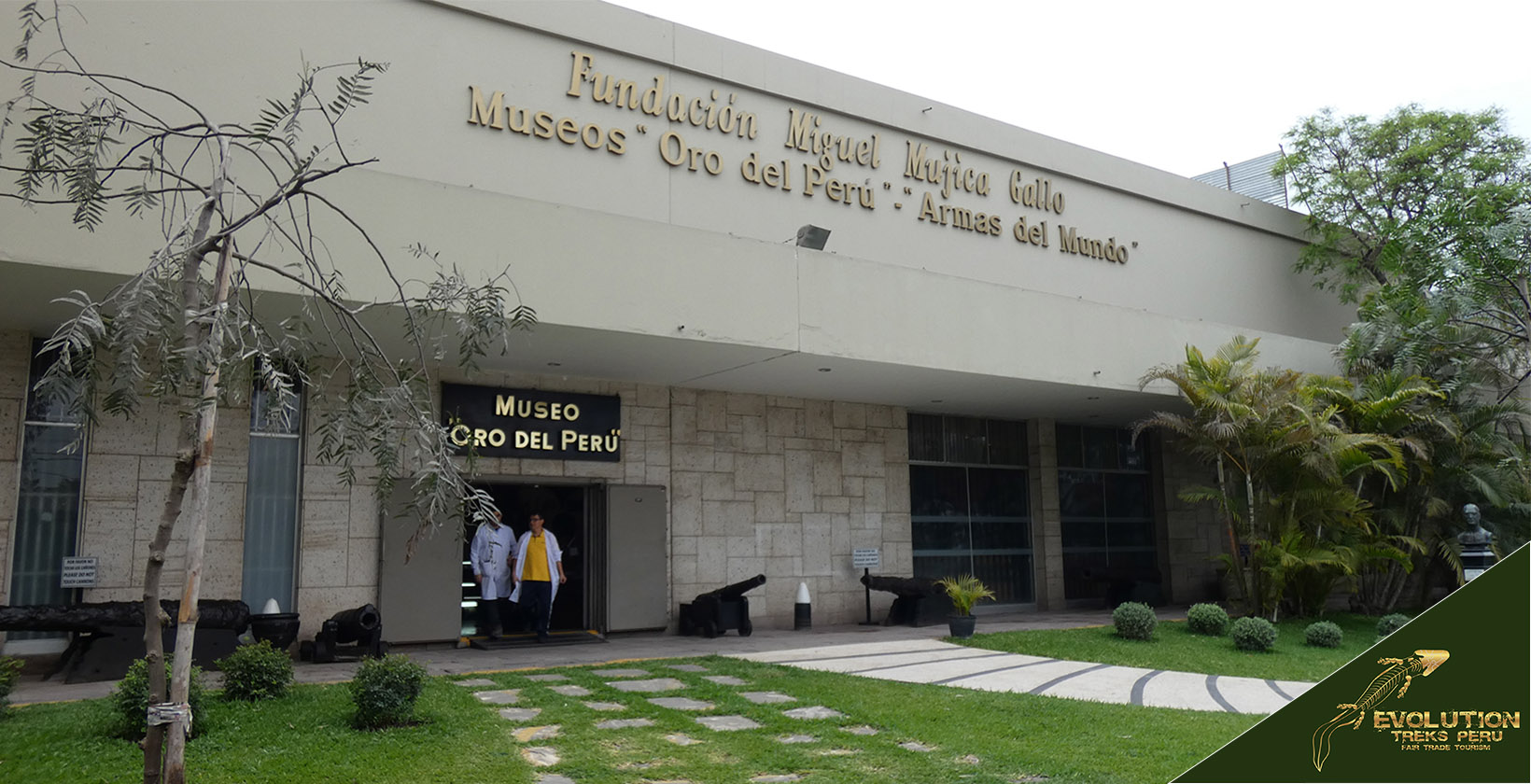
What to know before going to the Gold Museum of Peru and Weapons of the World
Before planning a visit to the Gold Museum of Peru and Weapons of the World, there are a few essential things to keep in mind:
- Operating hours: The Museum is open to the public on Mondays, Wednesdays, and Fridays from 10:00 a.m. to 3:00 p.m. It is closed on holidays such as January 1, May 1, July 28, and December 25.
- Group size: Only groups of 6 to 10 people are allowed at a time.
- Advance ticket purchase: To purchase your tickets in advance, you can contact the Museum by phone.
- Additional information: You can visit the Museum’s website or social media accounts (Facebook) for more information about the exhibits and other details about visiting the Museum.
- Keep in mind the safety protocols during COVID-19: The Museum may have safety protocols in place due to COVID-19, such as mandatory masks, social distancing measures, and temperature checks, be sure to check the Museum’s website or contact them before visiting to make sure you are aware of the safety measures.
How is the itinerary at the Gold Museum of Peru and Weapons of the World?
The itinerary in the Gold Museum of Peru and Weapons of the World is as follows:
- Start the rooms exhibiting various objects from ancient Peruvian cultures, such as openwork and embossed nose rings, mantles, bracelets, earrings, and tweezers.
- Continue to the rooms displaying Chimú art gold objects like pitchers with two spouts joined by a curved bridge; funeral masks painted red with stone hangings over the eyes; crowns with high plumes; ceremonial knives with filigree headdresses on their hilts.
- Proceed to watch the exhibits of textiles displayed in this Museum, including looms, feather fabrics, vases, huacos, and ceramics representing towns’ customs.
- End your tour by visiting the weapons section displays swords, hand cannons, shotguns, pistols, uniforms, horse saddles, and spurs armor, among others that marked history since 1 200 B.C..
How much does it cost to visit the Gold Museum of Peru and Weapons of the World?
The visit to the Gold Museum of Peru and Weapons of the World will vary in price depending on the age of the visitors. Adults must pay 33 soles (approximately 7 euros) to enter the Museum. For children under 14 years of age, the entrance fee has a significant discount, and they will only pay 16 soles (about 3.50 euros). Peruvian seniors and university students pay 16 soles.
What is the best vehicle to visit the Gold Museum of Peru and Weapons of the World?
The best vehicle to visit the Gold Museum of Peru and Weapons of the World, in case you are on a short stay in the city of Lima, is a cab.
Distances and prices will vary according to the district and place where you are staying.
Miraflores, San Isidro, and Lima Downtown, are the districts and places where most tourists stay and visit the capital of Peru.
Approximately a cab from San Isidro or Miraflores may charge 15 to 18 soles to reach your destination. The price also varies according to the time and amount of traffic at the time of service.
From downtown Lima, you can calculate 25 soles.

How many hours should a person spend in the Gold Museum of Peru and Weapons of the World?
A person should spend between three and four hours in the Museum of Gold of Peru and Weapons of the World, although some visitors prefer to stay five hours to see in detail the valuable exhibits housed in the different areas of the Museum.
Which is the closest city to the Gold and Weapons of the World Museum?
The Gold Museum of Peru and Weapons of the World is located in the city of Lima, the Capital of Peru.
How is the past of the Gold Museum of Peru and Weapons of the World presented to visitors?
If you love history, your visit to Lima will only be complete with visiting the Gold Museum and Weapons of the World. See the glittering gold objects from various eras at the Gold Museum before admiring the more than 20,000 different weapons housed in the Weapons of the World Museum. You will also be amazed by the war artifacts’ sheer quantity, quality, and quality. The weapons of famous historical and military figures such as Francisco Pizarro, Napoleon Bonaparte, and Simón Bolívar are one of the most symbolic displays to watch. You will be amazed to see the exquisite details, elegant armor, and katanas of the Japanese samurai.
Who are the scientists who worked on the Gold Museum of Peru and Weapons of the World?
The most important scientists and scholars that worked in the Gold Museum of Peru and Weapons of the World are the following.
- Dr. Miguel Mujica Gallo, a Peruvian archaeologist, was the lead scientist on the Gold Museum of Peru project.
- Dr. Luis Jaime Castillo Butters and his team from Lima’s San Marcos University also worked closely with Dr. Mujica Gallo on this project to create an accurate record of ancient Peruvian gold artifacts and weapons from around the world.
- Other scientists who contributed to this research included researchers from France’s Centre National de la Recherche Scientifique (CNRS), Mexico’s Universidad Nacional Autonoma de Mexico (UNAM), Germany’s Max Planck Institute for Archaeology, and Canada’s Simon Fraser University among others
How is the preservation of the Gold Museum of Peru and Weapons of the World?
The Museum of Peruvian Gold and Weapons of the World makes great efforts to preserve its collection of ancient artifacts with the guarantee that the pieces on display are authentic and are part of the history of Peru.
The Gold Museum of Peru and Weapons of the World spokesperson Claudia Rengifo Gracey says that even before the scandal in 2001, efforts were made to eradicate the fake pieces accidentally purchased by founder Miguel Mujica Gallo in the last years of his life.
The Museum employs archaeologists and conservators to authenticate the gold currently on display.
All the exhibits are registered with the Peruvian Ministry of Culture. That guarantees the authenticity of the sample presented to the visitors that come daily to visit the Museum of Gold of Peru and Weapons of the World.
Is the Gold Museum of Peru considered a Unesco World Heritage Site?
The Museum of Gold of Peru and Weapons of the World is not a Unesco World Heritage Site.
Is the Gold and Weapons of the World Museum at risk?
The Gold Museum of Peru and Weapons of the World put its prestige at risk in the early 2000s when it was seriously questioned by Peruvian authorities and international specialists for carrying out exhibitions of fake gold pieces in various national and international collections.
In the early 2000s, allegations surfaced that a large majority of the Museum’s gold pieces were fakes. The BBC reported that the Instituto de Defensa del Consumidor (Indecopi), together with specialists from the Pontificia Universidad Católica del Perú, had examined 4,257 pieces from the Museo del Oro and concluded that the vast majority were “fakes without a doubt”.
That rebuke was a severe blow to the national and international prestige of the Museum. After intense questioning by the press and the Peruvian Congress, the Museum of Peruvian Gold and Weapons of the World underwent reorganization. At present, the representatives of the Museum affirm that all the artifacts exposed are registered in the Ministry of Culture of Peru, with which its authenticity is guaranteed, and the severe denunciations that this collection suffered are overcome.
On the other hand, the Weapons of the World exhibit has never received any questioning or accusation. It has always been and continues to be, considered one of the best collections and exhibitions of historical weaponry in the American continent.
Is it safe to visit the Gold Museum of Peru and Weapons of the World?
It is safe to visit the Museum of Gold of Peru and Weapons of the World. It is located in the district of Surco, and one of the main residential districts of the city of Lima. In the interiors, the Museum has good security and spaces that guarantee the comfort of the visitors. However, as in any large and developed city, it is recommended to be very careful when moving from one place to another.
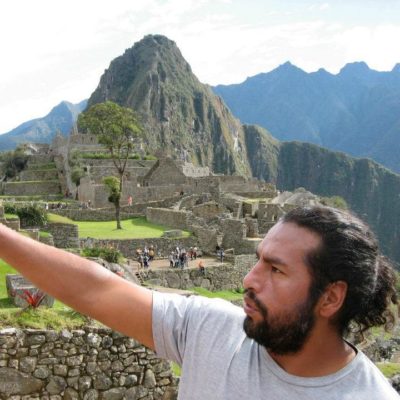
Miguel is a professional tour guide from Cusco, Peru, with almost 20 years of experience leading tours and a deep knowledge of Peru’s cultural and ecological diversity. He is also an advocate of ecotourism and cultural sensitivity and has lectured on these topics in the US and Europe. He co-founded Evolution Treks Peru, a worker-owned travel company based in Cusco.
